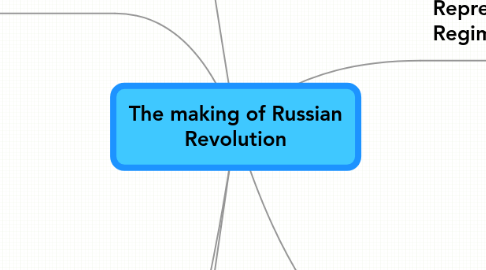
1. Industrialisation
1.1. begins to industrialise
1.1.1. policies of Vyshnegradsky
1.1.1.1. grain exports
1.1.1.1.1. paying for industry
1.1.1.1.2. famine
1.1.2. modernise
1.2. growing middle class
1.2.1. want doctors, professionals etc.
1.2.1.1. growing of cities
1.2.1.1.1. proffesionals
1.2.2. managers, finance, bankers
1.2.2.1. connected to industry
1.3. want a say
1.3.1. liberal ideas
1.3.2. lead to revolution
1.4. growing working class
1.4.1. terrible living/working conditions
1.4.1.1. housing problems
1.4.1.1.1. bed sharing
1.4.1.1.2. no running water
1.4.1.1.3. illness
1.4.1.1.4. crime
1.4.1.2. working conditions
1.4.1.2.1. no trade Unions
1.4.1.2.2. no health and safety
1.4.1.3. breeding ground for revolution
2. increasing peasant agitation
2.1. huge population growth
2.1.1. 50 million since 1850
2.1.1.1. peasants bored
2.1.1.1.1. sex
2.2. shortage of land
2.2.1. hatred of land owners
2.3. Witte's taxes
2.3.1. still low wages
2.3.2. bigger increase
2.4. Redemption payments
2.4.1. don't feel free
3. political opposition
3.1. liberals
3.1.1. growing support
3.1.1.1. stirs up agitation in Dec '04 and Jan '05
3.1.1.2. middle class
3.1.1.2.1. professionals
3.1.1.3. working class
3.1.1.3.1. from middle class
3.1.1.4. Nov 1904 Zemstva Banquet
3.1.1.4.1. demands on reform
3.1.1.4.2. secretly political
3.2. social democrats
3.2.1. formed in 1898
3.2.2. Marxism
3.2.3. don't cause revolution but play a part
3.2.4. split in two in 1903 in London
3.2.4.1. Mensheviks
3.2.4.1.1. Martov
3.2.4.1.2. envourage workers to join
3.2.4.2. Bolsheviks
3.2.4.2.1. much smaller wing
3.2.4.2.2. Lenin
3.2.4.2.3. means majority
3.2.4.2.4. small group of proffesionals to be ready
3.2.4.3. weak due to split
3.2.4.4. exiled or not in Russia
3.2.4.4.1. banned
3.2.5. Believe in karl Marx
3.2.5.1. middle class cause revolution first
3.2.5.1.1. industrialisation
3.2.5.2. working class take over second
3.2.5.2.1. educated to believe they don't need middle class
3.3. socialist revolutionaries
3.3.1. formed from populist movement in 1901
3.3.1.1. people's will etc.
3.3.2. revolution through peasants and worker
3.3.2.1. promised peasants land
3.3.2.1.1. had to politicise peasants
4. Short Term causes
4.1. Russo-Japanese War
4.1.1. national himiliation
4.1.2. Manchuria
4.1.2.1. assumed win
4.1.2.1.1. patriotism
4.1.2.1.2. series of defeats
4.1.2.1.3. logistically impossible
4.1.3. worsens economic problems
4.1.3.1. inflation
4.1.3.2. taxes up
4.2. Bloody Sunday
4.2.1. workers protest
4.2.1.1. led by Father Gapon
4.2.2. shooting of protestors
4.2.2.1. innocent un-armed crowds
4.2.2.1.1. 200 died
4.2.3. asking tsar to help
4.2.4. peaceful
4.2.4.1. petition on economic and political issues
4.2.5. 9th Jan 1905
4.3. Economic
4.3.1. no foreign investment
4.3.2. poor harves 1900-02
4.3.3. Depression by 1904
4.3.3.1. low wages
5. Repressive nature of Regime
5.1. Emergency Powers introduced in 1881
5.1.1. government courts for political opposition
5.1.2. Death of Father
5.1.3. Pobedonostev
5.1.4. Okhrana
5.1.4.1. Sent to exile
5.2. Education
5.2.1. 1884, Uni's under state control
5.2.2. schools under control of Orthodox church
5.3. Control of Legal System
5.3.1. 1889 land captain
5.3.1.1. chosen by gov
5.3.2. 1890 govt choose jury
5.4. censorship
5.4.1. foreign books banned
5.4.2. newspapers
5.4.3. 14 shot 1882-1889
5.5. Political control
5.5.1. 1892 Zemstva act, Town councils
5.5.2. 1890 Zemstva Act restricted franchise
6. Russification
6.1. intensified under Alexander II
6.1.1. 1885- Russian is official language
6.1.2. affects schools
6.1.3. Poland, Latvia, Georgia
6.1.3.1. intensifies anti-Russian feeling
6.1.3.1.1. opposite effect
6.1.4. increased Anti-Semitism
6.1.4.1. Pogroms
6.1.4.1.1. attacks on Jews
6.1.5. growing suppor for nationalist ideas
